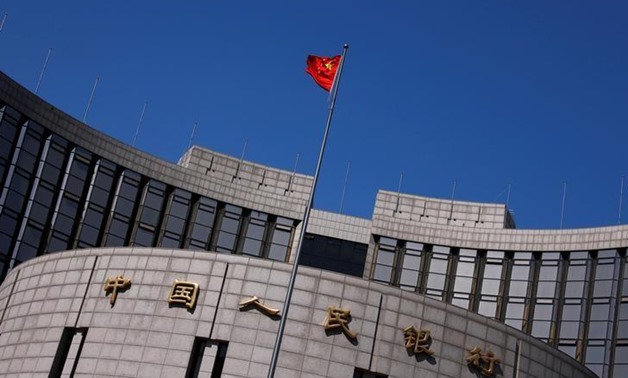
A Chinese national flag flutters outside the headquarters of the People's Bank of China, the Chinese central bank, in Beijing -REUTERS/Petar Kujundzic/Files
BEIJING - 30 September 2017: China’s central bank on Saturday cut the amount of cash that some banks must hold as reserves for the first time since February 2016 in a bid to encourage more lending to struggling smaller firms and energize its lacklustre private sector.
The People’s Bank of China (PBOC) said on its website that it would cut the reserve requirement ratio (RRR) for some banks that meet certain requirements for lending to small business and the agricultural sector.
The PBOC said that the vast majority of China’s banks would be eligible for at least a 50 basis point cut to their required reserve ratio as most met the minimum requirements to qualify.
“The size of the cut is big, it covers all big banks, and 90 percent of small and mid-sized banks. Conservatively we estimate 700 billion yuan in liquidity could be freed up,” analysts at Lianxun Securities said in a note.
The PBOC said the move was made to support the development of “inclusive” financial services and will be available to all medium and large-sized banks that meet requirements starting in 2018.
Analysts said the cut was different from previous changes to RRR in that it was a “delayed” cut that will not go into effect until next year.
“Clearly, the market will be disappointed as this cut will not help ease the liquidity conditions in the onshore banking system in the short term,” Zhou Hao, a Singapore-based analyst at Commerzbank, wrote in a note after the announcement.
The PBOC said the reserve requirement rate will be cut by 50 bps - or 0.5 percent - for banks whose loans to the targeted groups account for 1.5 percent of their outstanding loan balance or their newly added loans for the previous year.
A much higher bar is set for a further 100 bps cut: 10 percent of loans must be to the designated “inclusive finance” groups, the PBOC said. Banks that meet the 10 percent requirement will see their RRR cut by 150 bps.
FLAGGED
China’s cabinet had recently flagged a possible move, saying the government would take a number of measures, including tax exemptions and targeted reserve requirement ratio cuts to encourage banks to support small businesses.
The PBOC said the move was made to encourage more small loans - those under 5 million yuan - to small firms, loans to individual proprietors and lending that supports agricultural production, innovation, the poor and education.
The move is in line with existing policy to encourage more targeted lending to more vulnerable sectors of the economy, even as the government tries to cut down on speculative investment in the financial sector and property and rein in a rapid buildup in overall corporate debt.
But in the last two years, the central bank has preferred using new policy tools such as short- and medium-term lending facilities for a similar purpose. Most economists polled by Reuters had not expected an RRR move before 2018.
The PBOC said in a statement that the targeted RRR cut did not constitute a change to its prudent and neutral monetary policy.
RRR is the amount of cash as a percentage of deposits that banks must park at the central bank as reserves. The current rate for major banks was set at 17.0 percent after the last general RRR cut that took effect in March 2016.
Lianxun Securities said the RRR cut would help to offset negative impacts to smaller firms from strict environmental protection measures and capacity cuts, while also offering some liquidity relief to small and mid-sized financial firms.
The central bank in February extended a preferential programme that allows financial institutions that support rural finance and small enterprises to apply for a lower required level of cash reserves.
But despite still-strong credit growth nationwide, many small businesses and farmers remain in desperate need of funds and do not have easy access to ample cheap credit that state-run firms enjoy.
Also on Saturday, the central bank said it will maintain prudent and neutral monetary policy and use multiple monetary policy tools to keep liquidity basically stable.
The statement, which came after the third quarter meeting of the PBOC’s monetary policy committee, said China will continue with interest rate and exchange rate reform while keeping the yuan basically stable.
China’s economy grew 6.9 percent in the first half of the year, bolstered by a hot property market and a government infrastructure spending spree.
But business activity surveys have repeatedly shown large companies are reaping the benefits more than smaller ones.

Comments
Leave a Comment